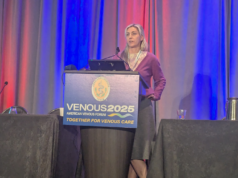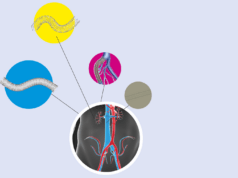 The deep venous world is wrestling with the question: To stent or not to stent. While the availability of new specialised venous stents is boosting popularity for the technique, there are some reservations about the appropriateness and risks of venous stenting. Stephen Black (Guy’s and St Thomas’ Hospital, London, UK) and Sriram Narayanan (The Harley Street Heart & Vascular Centre, London, UK) debated the topic at the International Union of Phlebology World Congress (UIP 2018; 4–8 February, Melbourne, Australia).
The deep venous world is wrestling with the question: To stent or not to stent. While the availability of new specialised venous stents is boosting popularity for the technique, there are some reservations about the appropriateness and risks of venous stenting. Stephen Black (Guy’s and St Thomas’ Hospital, London, UK) and Sriram Narayanan (The Harley Street Heart & Vascular Centre, London, UK) debated the topic at the International Union of Phlebology World Congress (UIP 2018; 4–8 February, Melbourne, Australia).
Black, arguing for the consideration of stenting as standard practice in treatment of deep venous obstruction, opened with a strong argument: “Physicians survive on keeping the disease going”, and to attain management of post-thrombotic syndrome, rather than prevention, the answer is anticoagulation only. Surgeons on the other hand, Black claimed, “sort the problem” and prevent post-thrombotic syndrome by early clot removal. This argument was met to some extent by Narayanan, who began his counter-arguments with the idea that stenting is a procedure that is increasingly done only because it is available. “Have a hammer—now everything is a nail”, Narayanan said. However, non-thrombotic iliac vein lesion sites can be highly varied, with multiple inflection points and high pressure zones present at different levels of the iliac venous system.
Therefore, Narayanan observed, “Different lesions need different stents, and the perfect stent is far from designed yet”. From the lack of ideal stent design, multiple problems can stem which Narayanan highlighted. “Stents can fracture and thrombose. Be prepared for re-interventions and re-re-interventions,” he said, pointing to the problems posed by difficulty to determine ideal stent sizing in terms of area, diameter, aspect ratio, “or just dumb luck”.
The parameters to measure and its haemodynamic significance have not been standardised, Narayanan objected. Until a more rigorous definition and understanding of stent sizing and the devices’ relationship to biomechanics, haemodynamics and venous obstruction is available—with long-term data from randomised controlled trials including quality of life measurements—Narayanan firmly maintained that stents should be used “with care and for a good reason,” rather than as a first-line approach.
Black, on the other hand, argued that “venous stenting is not new”, but rather a technique with a significant body of clinical work, including safety and efficacy data of stents currently in use. These stents are “necessary in acute, chronic, and non-thrombotic lesions”.
A live audience survey before and after the debate, however, revealed the compelling arguments made by Narayanan. The question, “Do we perform too much stenting for deep venous obstruction?” yielded 40% yes and 60% no before the debate. Posed directly after the debate, the question, “Deep vein obstruction: Should stenting be standard practice?” resulted in 17.6% yes, with 82.4% voting no.










Excellent Article covering the overuse of stents in the venous system